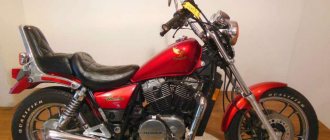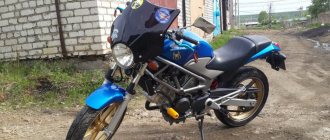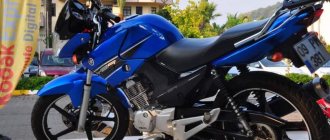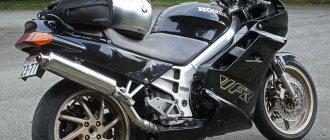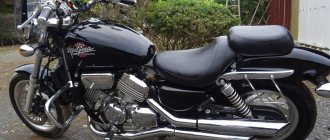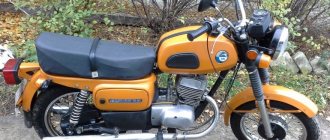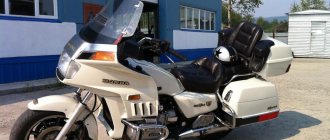Magna VF 750
- Honda motorcycle model
The Honda Magna 750 cruiser model appeared in 1982 as the “brother” of the Honda VF750S Saber model. The factory model designation is Honda VF750C. It became the first production cruiser with a V-shaped 4-cylinder engine from the Honda VFR750 sports tourer. The model was available in Japan, Europe and North America.
The first modifications of the Honda Magna 750 had the classic appearance of Japanese cruisers of that time - a short wheelbase, road fork offset, double disc brakes, cardan drive and hydraulic clutch.
Since 1987, the model has been seriously updated in appearance and receives the features of a power cruiser - a lower part, wide rear tires on a monolithic alloy wheel, expressive exhaust pipes, a stepped saddle and a front brake with a single disc. This generation has a maximum power of 77 hp. (Japanese versions), export modifications (North America, Great Britain) produced up to 88 hp.
Since 1993, the Magna model has undergone another major restyling. Getting a more modern appearance, it is also equipped with a chain drive (instead of a cardan), a cable clutch drive (instead of hydraulics), a new engine with a modified timing system, a 5-speed gearbox (previous versions - 5-speed + OD (overdrive), new wheels and carburetors with enlarged flaps.
2003 was the final year of production of the model, after which it left the assembly line and did not receive further development. However, throughout its production, the Magna 750 has won a huge army of fans around the world, who still prefer this particular model.
The “younger brother” of the model is the Honda Magna 250.
The model also has a name - Honda VF 750 Magna.
The main competitors of the Honda Magna 750 (V45) in the class:
Yamaha FZX 750
001_MOTO_0610_038
Honda VF750C Super Magna: cruiser, 1987–1989, 648 cm³, 70 hp, 90,000–180,000 rub.
Honda VF750C Super Magna: cruiser, 1987–1989, 648 cm³, 70 hp, 90,000–180,000 rub.
“Big”, “great”, “best”... And specifically in the feminine gender. If this Honda were a “man,” it would be a Magnum. It turns out that there is some kind of tautology in the name of the model: it seems that “magna” itself carries a superlative degree, and then there is also “super”. It turns out to be some kind of “super excellent” or “very great”. Let us not reproach the creators for excessive love of narcissism. The motorcycle really turned out excellent, both externally and internally.
1983. The history of the Magna family begins back in 1983, when the concern released two models: the “classic” Saber and the custom Magna. They are related by a 4-cylinder, 4-valve V-shaped power unit with a six-speed gearbox and cardan drive, built on the basis of the racing NR500, “inflated” to 750 cm3. Nowadays, every manufacturer has a “muscle custom” in its line—custom bikes with a sporty twist. Here is the HD V-Rod, and the Suzuki VZR1800Z, and the Honda VTX1800C... What about 20 years ago? To stick an engine (oh horror! - not a V-twin), and moreover, from a sportbike into a custom one - was considered crazy! In subsequent years, the motorcycle remained almost unchanged, except that versions with 1100 and 500 cc engines appeared.
1987. The revolution took place in 1987. Honda VF750C Super Magna became, perhaps, one of the first signs to notify the world that the Japanese have learned to make not only fast road cars, but also beautiful custom cars. If before almost all Japanese “choppers” were essentially more or less successful attempts to copy the style of the Great and Terrible HD, then the “super magna” is already a product of its own, independent and mature design school. The motorcycle created a sensation all over the world. A low, stretched silhouette, deliberately protruding covers of the airbox, which is not located at all in a classic place... and look at the brazenly raised exhaust pipes! The revolutionary design even now, after more than twenty years, does not look outdated. But just three years later, in 1989, the model was discontinued due to insufficient demand. Super Magna was well ahead of its time. But these days, motorcyclists have matured, and now clubs for Super Magna fans operate all over the world. Have you seen a club for fans of a twenty-year-old Japanese custom model? Time has caught up with the motorcycle that was born at the wrong time.
Review and test drive of the Honda VF750 Magna from Za Rulem magazine
No Latin dictionary or textbook gives a clear translation of the word magna, although those familiar with Latin or one of its derivative languages, be it Italian, English or French, have a rough understanding of what the word means.
“Big”, “great”, “best”... And specifically in the feminine gender. If this Honda were a “man,” it would be a Magnum. It turns out that there is some kind of tautology in the name of the model: it seems that “magna” itself carries a superlative degree, and then there is also “super”. It turns out to be some kind of “super excellent” or “very great”. Let us not reproach the creators for excessive love of narcissism. The motorcycle really turned out excellent, both externally and internally.
1983. The history of the Magna family begins back in 1983, when the concern released two models: the “classic” Saber and the custom Magna. They are related by a 4-cylinder, 4-valve V-shaped power unit with a six-speed gearbox and cardan drive, built on the basis of the racing NR500, “inflated” to 750 cm3. Nowadays, every manufacturer has a “muscle custom” in their line—custom bikes with a sporty twist. Here is the HD V-Rod, and the Suzuki VZR1800Z, and the Honda VTX1800C... What about 20 years ago? To stick an engine (oh horror! – not a V-twin), and moreover, from a sportbike into a custom one – was considered crazy! In subsequent years, the motorcycle remained almost unchanged, except that versions with 1100 and 500 cc engines appeared.
1987 . The revolution took place in 1987. Honda VF750C Super Magna became, perhaps, one of the first signs to notify the world that the Japanese have learned to make not only fast road cars, but also beautiful custom cars. If before almost all Japanese “choppers” were essentially more or less successful attempts to copy the style of the Great and Terrible HD, then the “super magna” is already a product of its own, independent and mature design school. The motorcycle created a sensation all over the world. A low, stretched silhouette, deliberately protruding covers of the airbox, which is not located at all in a classic place... and look at the brazenly raised exhaust pipes! The revolutionary design even now, after more than twenty years, does not look outdated. But just three years later, in 1989, the model was discontinued due to insufficient demand. Super Magna was well ahead of its time. But these days, motorcyclists have matured, and now clubs for Super Magna fans operate all over the world. Have you seen a club for fans of a twenty-year-old Japanese custom model? Time has caught up with the motorcycle that was born at the wrong time.
1993. In 1993, “at numerous requests from workers,” a completely new Magna appeared: “chain.” True, only the engine layout and name make it similar to the previous model. More traditional and quiet design, chain drive (hence the nickname), 5 gears - no more revolutions! Honda didn’t want to take risks, although apparently in vain. The army of Super Magna fans greeted the “chain” with an openly cold reception. Those who were waiting for the continuation of old traditions were left with their noses, and the latest “Magna” occupied a completely different niche, becoming more “just” a custom with an unusual engine.
DO NOT LOOK AT THE REGISTRATION . Super Magna was officially sold only in Japan and the United States. Unlike most “internal Japanese”, this model does not have electronics that limit the speed to 180 km/h, as well as engine “stranglers” in terms of power, so there is no fundamental difference between the modifications. Among the differences are the traditional US reflectors on the side surfaces of the fork and rear fender and the speedometer, marked in miles per hour. There is another version of the motorcycle - “California”. Due to the requirements of state environmental legislation, the motorcycle is equipped with a system for recirculating crankcase gases, gasoline vapors from the tank and other harmful “exhausts”. It can be identified by a plastic tank and a dozen additional rubber tubes entwined around the motorcycle. The system, as they say, “does not affect the speed,” so for Russia there is no fundamental difference in the presence or absence of this “mulka”.
“HALF A CUP” IS NOT EXTRA! There is also one little-known trick in “motor matters”: the first batches of Super Magna released for the United States market were equipped with engines with a displacement of 699 cm3. The reason for this was the high customs duties that 750 cc motorcycles were subject to. A year later, in '88, American customs tightened the screws even tighter, and now even 700 cc motorcycles fell into the same category as the 750. Since there were no longer any “customs” differences between the modifications, the basic 750 cc model began to be supplied to the American market. “Inner-Japanese” have always been only 750 cc. Therefore, if, when choosing a device, you come across an “American” made in 1987, pay attention to the displacement marking (it is cast on the side of the cylinder blocks).
POWER UNIT . The famous Honda V4 framed by Super Magna is an extremely reliable, well-developed and polished unit, free from “childhood diseases”. Even today, after more than 20 years and hundreds of thousands of kilometers, the engines work like clockwork. A peculiarity of the engine is a rather loud knocking of valves on a cold engine, which disappears only after warming up to operating temperature (7-10 minutes at idle). If the knocking does not go away, it means that the thermal clearances of the valves have “floated away” and adjustment is required. This procedure is quite labor-intensive - the layout of the motorcycle is very tight, and you will have to unscrew a lot of things, but the adjustment mechanism (screw - nut) is simple and does not require fussing with measurements and searching for adjusting washers. It is recommended to “feed” a highly accelerated, high-revving engine with sportbike roots with synthetic grades of oils for sports motorcycles. Arguments like “why does an old motorcycle need hi-tech” are completely unacceptable in this case. With cheap oil, the engine will last much less than expected. If you had to disassemble the engine for repairs, you should pay very close attention to the markings of similar parts (camshafts, rockers, etc.). It’s easy to confuse some parts during assembly, and even a Honda engineer cannot determine “by eye” which shaft comes from which head. Incorrect engine assembly will only lead to a scrap metal collection point.
REAR CYLINDER HEADS. The only technological “jamb” of the engine is the insufficient supply of oil to the rear cylinder heads. The reason for this is the poor design of the lubrication system. Oil enters the rear head of the block through the gearbox, where there are already plenty of lubricant consumers. In especially severe cases (especially when the crankcase contains budget semi-synthetics or, even worse, mineral water, as well as a low oil level), serious scuffing of the camshaft journals, their beds, cams and rockers occurs. To get rid of this problem once and for all, you can lay a new oil line directly from the oil pump to the head, bypassing the gearbox. Such tuning requires some experience, but in general there is nothing complicated about it. A reinforced brake hose can be used as an oil line.
CHASSIS . The motorcycle frame is designed extremely well for its time. Perhaps, Super Magna is one of the few custom cars of its time, the rigidity of the frame of which has no special complaints. Due to the long wheelbase, low center of gravity and significant fork angle, the motorcycle has excellent directional stability, which is why it is very popular among truck drivers, but with active maneuvering things are worse. The front fork with a tube diameter of only 39 mm and rather soft settings does not stand up to criticism. When cornering, it “twists” noticeably, which is facilitated by a significant angle of inclination. The situation is saved a little by installing a third yoke above the wing and filling with oil with a viscosity of 15W or even 20W. But you still shouldn’t expect sporty habits from an old custom car.
SO THAT THE STORE DOESN'T BEND . A serious problem is the rear shock absorbers. The youngest of the existing Super Magna is already 21 years old, and the non-separable shock absorbers for the most part have long since run out, especially if the motorcycle has had time to ride around Russia. The original units have long been discontinued, but you can still order them from the thrifty Japanese (albeit for crazy money). Used racks are a little cheaper at online auctions, but, of course, without any guarantee. There is a cheaper way out of this situation: tuning companies (for example, YSS) have not ignored our hero, so you can order quite budget aftermarket racks.
BRAKES . Perhaps the most striking “imprint of the past” is the braking system. The only disc with a two-piston floating caliper at the front does not correspond to the dynamic capabilities of the motorcycle and is clearly weak in the conditions of the modern rhythm of movement, and the rear “drum” with a mechanical drive is nothing more than a “dead weight” - there is practically no sense in it. You have to put up with this feature of the model - this is the problem with almost all old motorcycles. The only thing you should definitely do is install a reinforced hose. Most likely, no one has changed the “original” line, and Honda recommends replacing all brake hoses at least once every 6 years. And the feedback on the lever will noticeably improve.
STEERING WHEEL . The steering tube has an unusual welded structure, assembled from five separate elements. When choosing a motorcycle, you should carefully examine this unit. Even minor falls can cause welding to crack. There is no need to explain how dangerous it is to drive with such a defect.
VOLTAGE REGULATOR RELAY . A typical problem with old Hondas. It always fails completely unexpectedly. There can be only two reasons for this: either the battery has “decided to live for a long time”, or simply “the time has come.” In any case, before purchasing, it is better to check the functionality of the device. The voltage in the on-board network of a running motorcycle must be at least 13.5 V.
AIR FILTER . Due to the “antiquity” and low prevalence of the model in Europe, it is very difficult to find an original air filter in stock, and of the alternative manufacturers, only K&N offers its analogue, and then, according to its tradition, it is not paper, but reusable, with low resistance. So the owner is left with two options: either prudently order a new air filter a month and a half before the next maintenance, or install a serviced K&N.
EXHAUST SYSTEM . This is the pride and fetish of every magnet driver. Indeed, these “ends” are still firmly in the top ten of the world beauty contest of exhaust systems. But there are problems here too. Sometimes the lower pipe bends located under the engine burn out. Depending on the general condition of the assembly, you can either weld it with a sheet of steel, or, if things are really bad, look for a replacement - of course, a used one. Of course, you can “prank” tuning pipes, but this is akin to installing wheels from a Gazelle on a Rolls-Royce. The second “headache” for magnetic guides is the chrome-plated sliders at the ends of the pipes. In theory, they are designed to protect pipes during falls, sacrificing themselves, but often these linings simply fly away, becoming loose from vibrations. These decorative elements, of course, do not affect the driving performance, but the appearance of the “main pride” of the motorcycle suffers significantly, so when buying a device you can safely bargain for a round sum (see the spare parts table).
Source: magazine "Behind the Wheel"
Go to the Honda Magna 750
- Read review of Honda Magna 750
Check out the test drives:
- Review and test drive of the Honda VF750 Magna from Motorreview magazine
- Test drive Honda VF750 Magna from Motorreview magazine
- Test drive Honda VF750 Magna from Motorreview magazine
- Test drive Honda VF750 Magna from Motorreview magazine
- Test drive Honda VF750 Magna from Motorreview magazine
008_MOTO_0610_039
1993. In 1993, “at numerous requests from workers,” a completely new Magna appeared: “chain.” True, only the engine layout and name make it similar to the previous model. More traditional and quiet design, chain drive (hence the nickname), 5 gears - no more revolutions! Honda didn’t want to take risks, although apparently in vain. The army of Super Magna fans greeted the “chain” with an openly cold reception. Those who were waiting for the continuation of old traditions were left with their noses, and the latest “Magna” occupied a completely different niche, becoming more “just” a custom with an unusual engine.
DO NOT LOOK AT THE REGISTRATION. Super Magna was officially sold only in Japan and the United States. Unlike most “internal Japanese”, this model does not have electronics that limit the speed to 180 km/h, as well as engine “stranglers” in terms of power, so there is no fundamental difference between the modifications. Among the differences are the traditional US reflectors on the side surfaces of the fork and rear fender and the speedometer, marked in miles per hour. There is another version of the motorcycle - “California”. Due to the requirements of state environmental legislation, the motorcycle is equipped with a system for recirculating crankcase gases, gasoline vapors from the tank and other harmful “exhausts”. It can be identified by a plastic tank and a dozen additional rubber tubes entwined around the motorcycle. The system, as they say, “does not affect the speed,” so for Russia there is no fundamental difference in the presence or absence of this “mulka.”
“HALF A CUP” IS NOT EXTRA! There is also one little-known trick in “motor matters”: the first batches of Super Magna released for the United States market were equipped with engines with a displacement of 699 cm3. The reason for this was the high customs duties that 750 cc motorcycles were subject to. A year later, in '88, American customs tightened the screws even tighter, and now even 700 cc motorcycles fell into the same category as the 750. Since there were no longer any “customs” differences between the modifications, the basic 750 cc model began to be supplied to the American market. “Inner-Japanese” have always been only 750 cc. Therefore, if, when choosing a device, you come across an “American” made in 1987, pay attention to the displacement marking (it is cast on the side of the cylinder blocks).
Modifications
No official modifications were made based on the motorcycle. But if you remember the third generation, which completely changed the chassis, it can be considered a variation.
Over the many years of production, the motorcycle changed colors several times.
and competitors
Despite the fact that the Honda model has long been considered a standard cruiser, competitors failed .
Only Yamaha . Its road bike FZX 750 , born in 1986, nicknamed outside Japan “the first Fazer” (the legendary liter would be born only 15 years later), could in many ways compete with Honda’s cruiser, but could not become a full-fledged replacement.
002_MOTO_0610_038
Honda VF750C Super Magna
Honda VF750C Super Magna
POWER UNIT. The famous Honda V4 framed by Super Magna is an extremely reliable, well-developed and polished unit, free from “childhood diseases”. Even today, after more than 20 years and hundreds of thousands of kilometers, the engines work like clockwork. A peculiarity of the engine is the rather loud knocking of valves on a cold engine, which disappears only after warming up to operating temperature (7-10 minutes at idle). If the knocking does not go away, it means that the thermal clearances of the valves have “floated away” and adjustment is required. This procedure is quite labor-intensive - the layout of the motorcycle is very tight, and you will have to unscrew a lot of things, but the adjustment mechanism (screw - nut) is simple and does not require fussing with measurements and searching for adjusting washers. It is recommended to “feed” a highly accelerated, high-revving engine with sportbike roots with synthetic grades of oils for sports motorcycles. Arguments like “why does an old motorcycle need hi-tech” are completely unacceptable in this case. With cheap oil, the engine will last much less than expected. If you had to disassemble the engine for repairs, you should pay very close attention to the markings of similar parts (camshafts, rockers, etc.). It’s easy to confuse some parts during assembly, and even a Honda engineer cannot determine “by eye” which shaft comes from which head. Incorrect engine assembly will only lead to a scrap metal collection point.
REAR CYLINDER HEADS. The only technological “jamb” of the engine is the insufficient supply of oil to the rear cylinder heads. The reason for this is the poor design of the lubrication system. Oil enters the rear head of the block through the gearbox, where there are already plenty of lubricant consumers. In especially severe cases (especially when the crankcase contains budget semi-synthetics or, worse, mineral water, as well as a low oil level), serious scuffing of the camshaft journals, their beds, cams and rockers occurs. To get rid of this problem once and for all, you can lay a new oil line directly from the oil pump to the head, bypassing the gearbox. Such tuning requires some experience, but in general there is nothing complicated about it. A reinforced brake hose can be used as an oil line.
Notes[edit]
- Holmstrom (2000)
- Bartels (1997)
- ^ B s d e g h Mayershon (1985)
- Lawrence (2006)
- Canvest (2009)
- ↑
Lawrence, Leah (July 18, 2006).
"Motorcycle racing grandma travels the world". www2.canada.com
. Vancouver sun. Archived from the original on May 9, 2012. Retrieved October 6, 2013. - ↑
Hannah (2008) - "Honda Magna V-45". Cycle World Magazine. May 1982 p. 47. Cite magazine requires |magazine=(help)
- ^ ab "Honda V65 Magna", Cycle World
, pp. 48–55, April 1983 - ^ B s d e e Scott, Ed (1984). Honda: V45 & V65, maintenance, repair, operation
(1st ed.). Arleta, CA: Clymer Publications. ISBN 0-89287-384-1. - Ford (1985)
- “Honda V64 Magna; from the people who brought us VHD, TRAC, FOIL and CVCC comes TBBYES (The Coolest Bike You've Ever Seen),” Cycle World
, Newport Beach, CA: Hachette Filipacchi Media US, vol. 22 no. 4, pp. 49–55, April 1983, ISSN 0011-4286. - ^
Hill, Ray (December 1983), "We Test the World's Fastest Superbikes",
Popular Mechanics
, pp. 91–, retrieved July 4, 2015 - Russell, Alan; McWhirter, Norris D. (1986), Guinness Book of World Records, Superior Guinness, ISBN 978-0-85112-439-1
- McFarlane, Donald; Boehm, David A. (1988), Guinness Book of World Records, 1989, Guinness Superlatives, ISBN 978-0-8069-0276-0
- Jump up ↑
Brown, Roland (2006),
The Ultimate History of Fast Motorcycles
, Bath, UK: Parragon, pp. 214–215, ISBN 1-4054-7303-7 - Solomon R. Guggenheim Museum, Field Museum of Natural History, Guggenheim Museum Bilbao (2001), Krens, Thomas (ed.), The Art of the Motorcycle
, Guggenheim Museum, ISBN 978-0-8109-6912-4CS1 maint: multiple names: authors list (link) - Walker, Mick (2006), The Motorcycle: Evolution, Design, Passion, JHU Press, pp. 172, 174–5, ISBN 978-0-8018-8530-3
- "Honda VF500 Magna Print Ad". Retrieved January 8, 2008.
- ^ abcd "Honda VF500 Magna and Interceptor". Retrieved January 8, 2008.
- ^ abcd "Performance Index Winter '12/'13 Edition" (PDF), Motorcycle Consumer News
, BowTie, January 2013, archived from the original (PDF) on December 29, 2016, retrieved September 15, 2016.
007_MOTO_0610_039
The sporty nature of the motorcycle is emphasized by the instrumentation in sportbike colors: the tachometer is dominant, the speedometer is secondary.
The sporty nature of the motorcycle is emphasized by the instrumentation in sportbike colors: the tachometer is dominant, the speedometer is secondary.
CHASSIS. The motorcycle frame is designed extremely well for its time. Perhaps the Super Magna is one of the few custom cars of its time with no particular complaints about the frame rigidity. Due to the long wheelbase, low center of gravity and significant fork angle, the motorcycle has excellent directional stability, which is why it is very popular among truck drivers, but with active maneuvering things are worse. The front fork with a tube diameter of only 39 mm and rather soft settings does not stand up to criticism. When cornering, it “twists” noticeably, which is facilitated by a significant angle of inclination. The situation is saved a little by installing a third yoke above the wing and filling with oil with a viscosity of 15W or even 20W. But you still shouldn’t expect sporty habits from an old custom car.
SO THAT THE STORE DOESN'T BEND. A serious problem is the rear shock absorbers. The youngest of the existing Super Magna is already 21 years old, and the non-separable shock absorbers for the most part have long since run out, especially if the motorcycle has had time to ride around Russia. The original units have long been discontinued, but you can still order them from the thrifty Japanese (albeit for crazy money). Used racks are a little cheaper at online auctions, but, of course, without any guarantee. There is a cheaper way out of this situation: tuning companies (for example, YSS) have not ignored our hero, so you can order quite budget aftermarket racks.
Links[edit]
- Bartels, Billy (February 20, 1997), First Impression: 1997 Honda 750 Magna, Motorcycle.com
- Canwest News Service (29 January 2009), "Motorcycle grandma chronicles second leg of world tour", Calgary Herald
, archived from the original on 21 May 2015. - Carrithers, Tim (March 2009), "Smart Money: 1993-2004 Honda Magna 750. (MC GARAGE) (Product/Service Evaluation)", Motorcyclist
, p. 102 - Cherney, Andy, Honda Magna 750: heavy middleweight motorcycle; Honda Magna 750cc - Road Test & Review, Motorcycle Cruiser, archived from the original on July 19, 2012, retrieved July 13, 2009.
- Farnsworth, Clyde H. (April 2, 1983), "US RAISE MOTORCYCLE TARIFFS," The New York Times.
, New York, NY, p. 1, ProQuest 424627452 - Ford, Dexter; Carr, Jeff (February 1985), "1985 Muscle Bike Buyer's Guide", Hot Rod
,
38
, pp. 82(3) - Hannah, James; Associated Press (February 27, 2008), "Honda to end motorcycle production in the US", Boston Globe
- Holmstrom, Darwin (2001), The Complete Idiot's Guide to Motorcycles (2nd ed.), Alpha Books, p. 321, ISBN 0-02-864258-9
- Holmstrom, Darwin (June 2000), "1983 Honda V45 Interceptor", Motorcyclist
, page 146 - Lawrence, Leah (July 18, 2006), “Motorcycle Grandma Travels the World; Edmonton woman sold everything she owned to fund her trip to Asia, Europe and South America,” The Vancouver Sun
, archived from the original May 9, 2012. - Maiershon, Norman (December 1985), "Brute Bicycles. Cruising through California's Gold Country in the fastest big-bore cruisers, our team tests the limits of cars, roads and riders." , Popular Mechanics
, pp. 106–9, 139, 142–3. - “V-Max, Lean And Mean Machines; Honda Magna 1994 and Yamaha 1993", Motorcycle Consumer News
, September 1993 - "1999 Honda Magna", Motorcycle Consumer News
, July 1999 - Scott, Ed (1984). Honda: V45 & V65, maintenance, repair, operation
(1st ed.). Arleta, CA: Clymer Publications. ISBN 0-89287-384-1.
003_MOTO_0610_039
The rear drum brake shows the age of the model.
And even though the pads last for many tens of thousands of km, their effectiveness is “nothing.” The rear drum brake shows the age of the model. And even though the pads last for many tens of thousands of km, their effectiveness is “nothing.”
BRAKES. Perhaps the most striking “imprint of the past” is the braking system. The only disc with a two-piston floating caliper at the front does not correspond to the dynamic capabilities of the motorcycle and is clearly weak in the conditions of the modern rhythm of movement, and the rear “drum” with a mechanical drive is nothing more than a “dead weight” - there is practically no sense in it. You have to put up with this feature of the model - this is the problem with almost all old motorcycles. The only thing you should definitely do is install a reinforced hose. Most likely, no one has changed the “original” line, and Honda recommends replacing all brake hoses at least once every 6 years. And the feedback on the lever will noticeably improve.
1994–2003 (VT250C) Magna[edit]
1994–2003 VT250C
| 1995 Honda Magna with aftermarket exhaust | |
| Manufacturer | Honda |
| Also called | VT250 |
| Engine | 250 cc liquid cooled, 90°, V-2, bore x stroke: 60.0 x 44.1 mm (2.36 x 1.74 in), compression 11.0:1 |
| Transmission of infection | 5-speed, final drive: O-ring chain, multi-plate coil spring clutch |
| Suspense | Front: telescopic type, rear: swing arm type |
| Brakes | Front: Hydraulic disc, Rear: Mechanical drive/tail shoe |
| Tires | Tubeless, front: 120/80–17 61S, rear: 150/80–15M/C 70S |
| Wheelbase | 1.620 mm |
| Dimensions | L: 2315 mm W: 845 mm H: 1055 mm |
| Seat height | 28.0 inches (711 mm) |
| Fuel tank capacity | 11 liters (2.91 US gal) |
| Oil capacity | 2.1 liters (after changing oil and filter) |
004_MOTO_0610_039
The welded steering wheel is an unusual design.
When dropped, it does not bend as usual, but cracks along the welding seams. The welded steering wheel is an unusual design. When dropped, it does not bend as usual, but cracks along the welding seams.
STEERING WHEEL. The steering tube has an unusual welded structure, assembled from five separate elements. When choosing a motorcycle, you should carefully examine this unit. Even minor falls can cause welding to crack. There is no need to explain how dangerous it is to drive with such a defect.
VOLTAGE REGULATOR RELAY. A typical problem with old Hondas. It always fails completely unexpectedly. There can be only two reasons for this: either the battery has “decided to live for a long time”, or simply “the time has come.” In any case, before purchasing, it is better to check the functionality of the device. The voltage in the on-board network of a running motorcycle must be at least 13.5 V.
006_MOTO_0610_039
The “K&N” low resistance filter is an excellent alternative to the “original”, which you won’t find during the day.
The “K&N” low resistance filter is an excellent alternative to the “original”, which you won’t find during the day.
AIR FILTER. Due to the “antiquity” and low prevalence of the model in Europe, it is very difficult to find an original air filter in stock, and of the alternative manufacturers, only K&N offers its analogue, and then, according to its tradition, it is not paper, but reusable, with low resistance. So the owner is left with two options: either prudently order a new air filter a month and a half before the next maintenance, or install a serviced K&N.
Driving characteristics (dynamics, acceleration)
A sufficient number of horses under the tank of the motorcycle allows you to move off dynamically and confidently accelerate from 100 km/h.
According to the developer's specifications, the maximum speed is 196 km/h . The owners note that at 160 km/h the wind begins to blow, but the power reserve is felt, so 190 is quite possible. Therefore, a comfortable cruiser is 120 km/h .
Acceleration from zero to 100 km/h in 4.3 seconds . According to user reviews, if we do not forget that this is a cruiser, for which sedate, leisurely driving is considered more normal, the performance is beyond praise.
Fuel consumption
According to the manufacturer's documentation, consumption is 2.63 to 4.52 liters per 100 km. But these are Japanese data. Owners in the Russian Federation note that you are unlikely to see anything below 5 liters. And if you anneal it, then all 10 liters .
The final result depends on your riding style. 13 liter tank means a mileage of no more than 200 km on one fill-up .
005_MOTO_0610_039
The release is the pride and beauty of Supermagna.
But the protective pads are often lost. The release is the pride and beauty of Supermagna. But the protective pads are often lost.
EXHAUST SYSTEM. This is the pride and fetish of every magnet driver. Indeed, these “ends” are still firmly in the top ten of the world beauty contest of exhaust systems. But there are problems here too. Sometimes the lower pipe bends located under the engine burn out. Depending on the general condition of the assembly, you can either weld it with a sheet of steel, or, if things are really bad, look for a replacement - of course, a used one. Of course, you can “prank” tuning pipes, but this is akin to installing wheels from a Gazelle on a Rolls-Royce. The second “headache” for magnetic guides is the chrome-plated sliders at the ends of the pipes. In theory, they are designed to protect pipes during falls, sacrificing themselves, but often these linings simply fly away, becoming loose from vibrations. These decorative elements, of course, do not affect the driving performance, but the appearance of the “main pride” of the motorcycle suffers significantly, so when buying a device you can safely bargain for a round sum (see the spare parts table).
ESTIMATED COST OF SPARE PARTS HONDA VF750C Super Magna
Name | Original spare parts, rub. | Non-original spare parts, rub. |
| Oil filter | 620 | 370 (Hiflo) |
| Air filter | 1300 | 2000 (K&N) |
| Spark plugs (set) | 650 (NGK-Honda) | 500 (NGK) |
| Brake pads (set for two wheels) | 3100 | 2200 (Vesrah) |
| Muffler cover (1 piece) | 750 | — |
| Relay regulator | 11 200 | 3000 |
| Rear shock absorbers (set) | 28 000 | from 7000 (YSS) |
Spare parts, mostly available in stock.
Spare parts are sometimes in stock. Spare parts, mainly imported to order. We thank Yuri Borzunov for his help in preparing the material and the motorcycles provided for filming. Honda VF750C Super Magna
